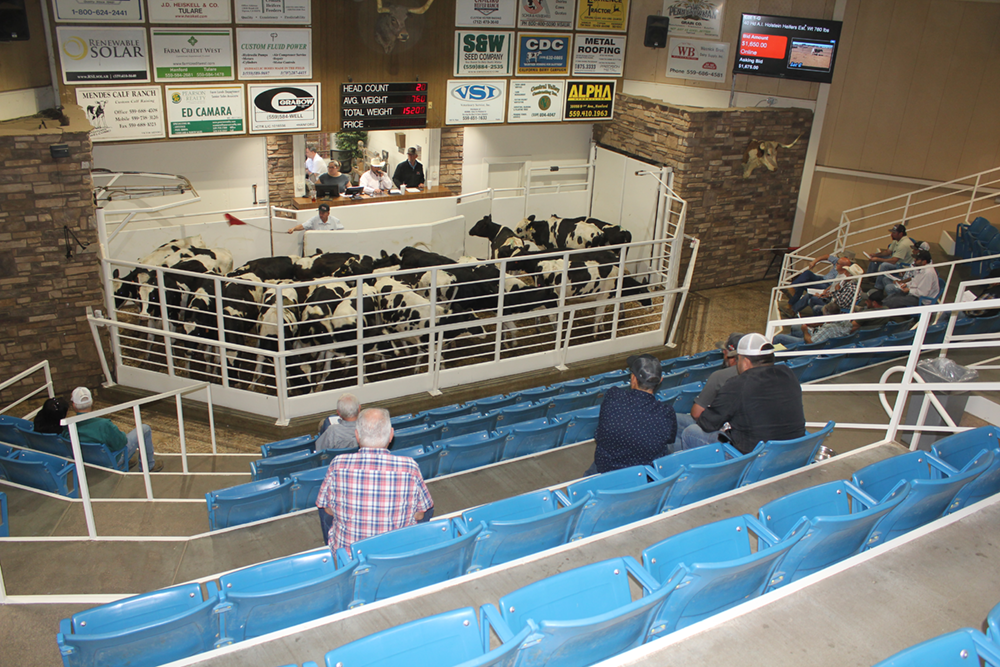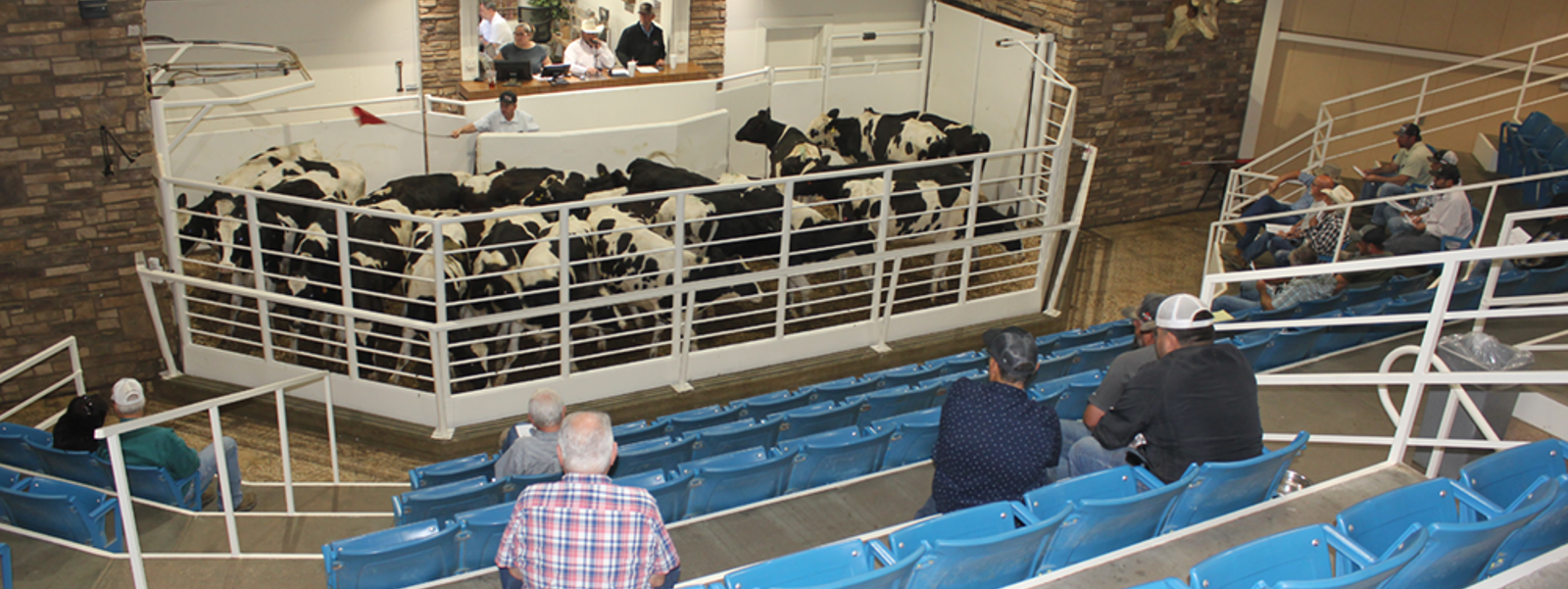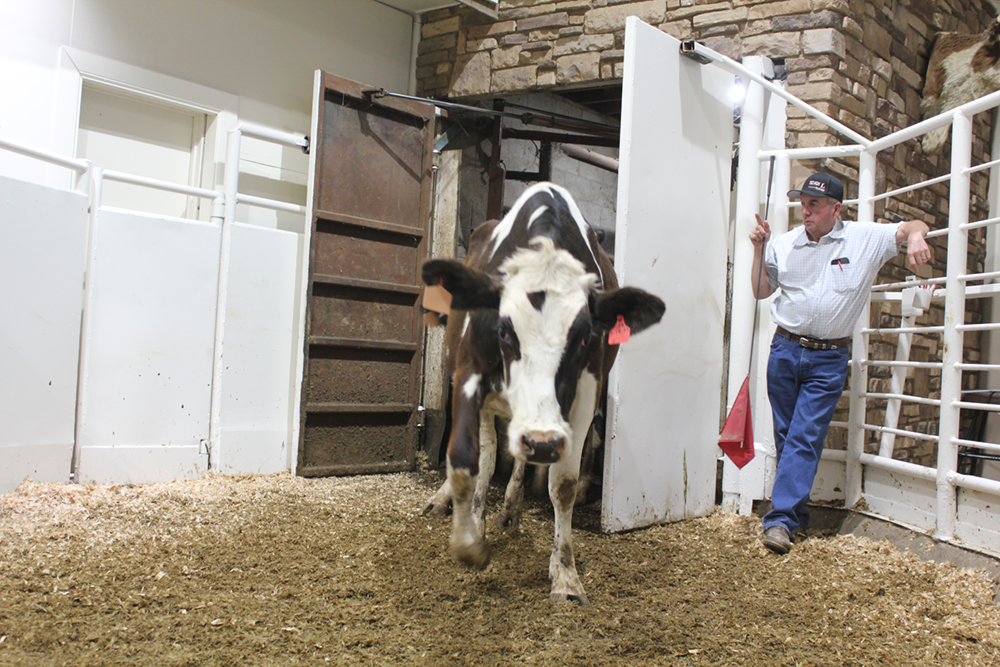Stockyards size impact of bird flu testing

At Overland Stockyard in Hanford, a group of Holstein dairy heifers move through the auction ring. Livestock auction yards are affected by a new federal order that requires all lactating dairy cows test negative for avian influenza before interstate movement. Heifers are not included in the mandate.
Photo/Cecilia Parsons


Photo/Cecilia Parsons
By Ching Lee
Efforts to better understand and curb the spread of H5N1 avian influenza in dairy cows have livestock auction yards in a scramble as new federal testing requirements took effect last week.
Under the U.S. Department of Agriculture rule, all lactating dairy cows must test negative for the flu virus before they’re allowed to cross state borders. Businesses that market livestock say they’re trying to adapt to the mandate, which has impacted sellers and buyers of milking cows.
Tyson Howze, a representative of Overland Stockyard in Hanford, said the company conducts a lot of dispersal sales for dairies across the West and Southwest. The auctions are held live and online, with buyers from as far as a thousand miles away bidding. He estimated more than 25% of the dairy cows from a typical California dispersal sale goes to out-of-state buyers.
The stockyard has been preparing for a dispersal sale next week of milking cows and dry cows from a Fresno County dairy. During such sales, Howze said there’s usually “quite a bit of commerce” between California, neighboring states such as Arizona and other major dairy states such as Texas. But with this upcoming sale, he said he does not anticipate moving any lactating cows out of state due to the new testing requirements, as buyers in other states will be reluctant to bid. That will hurt the dairy selling the cows, he said.
“It’s going to have to be that way until everybody gets a handle on how the testing goes,” Howze said.
So far, there have been no confirmed cases of avian influenza in California dairy cows. But the testing mandate puts dairy farmers in a difficult position. Howze said farmers and stockyards want to follow the rules and cooperate with officials, “but nobody wants to be the first to test positive either.”
A positive test would trigger more testing and animal traceback. Even false-positive test results could bring disruptions to the dairy, he said, including restrictions on shipping animals out of state for 30 days.
“Nobody wants everybody coming into their dairy to start testing things if they don’t have a problem,” Howze said.
Impacts of avian influenza come at a time when dairy farmers are already hurting from lower milk prices and rising production costs, said Stanislaus County dairy farmer Pete Verburg. Those who carry a lot debt are most vulnerable as interest rates on loans remain high. He lamented the growing number of dairies selling their cows and going out of business—and how impacts of avian influenza and the testing requirements could make the process more difficult.
With the nation’s short supply of beef cattle, more dairies are also cross-breeding their cows to beef genetics and selling them at higher prices to earn additional income. Now some of those dairies are looking to replenish their herds, and they’re buying not just replacement heifers but lactating milk cows, Verburg said.
A typical dairy replaces 30% of its cows annually, Howze said. Dairy farmers in states whose herds have been affected by avian influenza need immediate replacements and are buying milking cows “to fill in the holes.”
In affected herds, about 10% to 20% of cows become sick. Though most cows recover, some may not return to full milk production.
But the burden of testing could discourage out-of-state participation, potentially bringing lower prices to sellers. The testing requirements could also impact dairies that move their milking cows to feedlots in other states, Howze said.
Dairies most often move young stock, said Anja Raudabaugh, CEO of Western United Dairies, “but occasionally lactating animals do get moved.” It happens more frequently on the North Coast, she noted, where dairies may ship their cattle to Oregon or Washington.
“It also happens on dairy farms that have ownership out of state,” she said. “Those farmers may move those animals between dairies in California and New Mexico, for example.”
The testing requirements—which exclude dairy heifers, dry cows, bull calves and culled cows going to slaughter—took effect April 29.
With a video sale to prepare for later that week, Jake Bettencourt, owner of Turlock Livestock Auction Yard in Stanislaus County, said it was “all hands on deck here trying to continue our commerce while under the new federal order.”
Even though last week’s video sale involved mostly young stock that do not require testing, there were also lactating cows being sold. One concern is with the seven-day window given to ship an animal from when the test was taken. Even in a perfect world, Bettencourt said, it would take at least four days to send a sample to the lab, run the test and get results back.
“Now you have three days to coordinate trucking and logistics to ship however many cattle are in that transaction,” he said. “That’s incredibly challenging. It’s definitely going to impede commerce.”
When USDA first announced the rule late last month, Forrest Mangan, western region executive officer for Kansas-based Livestock Marketing Association, said “there was a lot of confusion throughout the day about exactly how it’s going to affect the auction markets.” Though auction yards have been “planning accordingly,” he said, they also have “some definite concerns” about the tests and the “super tight” timeline allowed to ship the animals.
“It’s definitely changed the way we do things a little bit,” he said.
Lactating dairy cows account for a small percentage of what’s sold at California auction yards, which market mostly culled cows, Mangan said. That’s why it was significant that the testing mandate excluded culled cows going straight to slaughter, even those that are shipped to packing plants in another state, he said.
With no dairy sales on his immediate calendar, Richard Martella, co-owner of A&M Livestock Auction in Hanford, said the new testing requirements haven’t yet affected his business. Though he hasn’t studied the rule in detail, he said the order appears “very cut and dry.”
“You do what the state and federal government asks you to do,” Martella said. “If you don’t want to comply, you don’t move your herd.”
With no known positive cases in California, Mangan said auction yards have not had to implement any biosecurity measures. Culled cows typically arrive at the sale in the morning, go through the ring and are shipped out the same night, he noted.
Dairy farmer Verburg said he also has not done anything differently in his operation other than require people coming to the farm to “make darn sure that everything you are wearing or using is clean.”
“But can they guarantee it? No, they cannot,” he said.
USDA said last week it remains confident the meat supply is safe, noting that 30 ground beef samples it tested from retail outlets in states with H5N1-positive dairy herds all came back negative for the virus. Results are still forthcoming on beef muscle samples taken at federally inspected slaughter facilities of culled dairy cows that had been condemned for systemic pathologies, USDA reported.
Government researchers also are conducting a cooking study using a virus surrogate in ground beef to determine how much of the pathogen is eliminated at different temperatures. Those results will be posted as soon as they become available, USDA said.
(Ching Lee is an assistant editor of Ag Alert. She may be contacted at clee@cfbf.com.)




